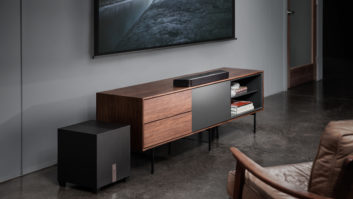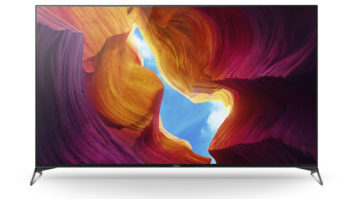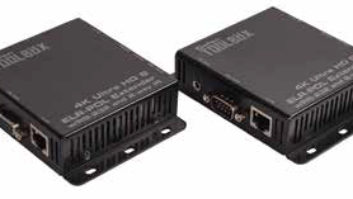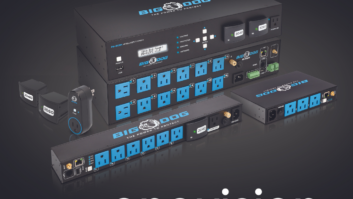There’s more than a little confusion about CEC, the “Consumer Electronics Control” standard, built into most residential HDMI devices. The majority of AV integrators are disabling it, arguing that CEC is confusing, poorly documented, and more likely to cause trouble than to help. That’s a mistake, others argue.

Above: CEC can be great if you’re plugging HDMI components directly into a TV. When you start to build systems using an AV receiver, however, then you may bump into problems with the standard.
Jim Ares, senior systems designer for Sudbury, MA-based Home Entertainment Expo (HEE), says that CEC can be very useful in smaller systems now and may become a crucial factor in large installations in the next year or so.
A Confusing Standard
In simple terms, CEC is a series of commands dreamed up by HDMI Licensing LLC to allow users to control multiple devices from a single remote control and to automate many functions. Press “play” on a Blu-ray player, for example, and it can power up your TV automatically and switch it to the proper input. When you finish your movie, power down the Blu-ray, and it can power down the rest of the audio/video system as well. If you have a chain of devices connected via HDMI cables, you can theoretically control all of them with a single remote control, even if only one has an IR or RS-232 input.
CEC gets confusing because, while the HDMI standard mandates a core set of CEC commands, it does not require CEC be included in every HDMI device. So while most consumer-grade HDMI components include the command set, manufacturers of “custom-centric” gear tend to leave it out, relying instead on RS-232 control. In addition, the standard allows manufacturers to add their own proprietary commands to the CEC control set, and these commands do not transfer from one brand to another. Finally, various manufacturers identify CEC under their own brand names. Most people do not realize that Sony BRAVIA, Samsung Anynet+, and LG SimpleLink are all implementations of CEC and are, on a basic level, compatible with each other.
What’s needed is for the electronics manufacturers to provide a comprehensive way to manage CEC. So far only one, Crestron, is doing so.
CEC in Simple Setups
Despite all these drawbacks, Ares says his company regularly uses CEC as an inexpensive way to give clients extra functionality, while differentiating Home Entertainment Expo from local big box stores in the process.
“CEC is great if you’re plugging HDMI components directly into a TV. It works well and it’s pretty much foolproof,” he said. “We do tend to play it safe by buying components for these small systems all within the same brand, but you don’t have to. I have a Sony Blu-ray at home that I’m using with a Pioneer TV, and the CEC controls are working just fine.”
When you start to build systems using an AV receiver, however, then you may bump into problems with CEC. “It seems like the receiver manufacturers are always a little behind the times,” Ares said. “So when we use a receiver, we generally like to use some kind of control system, and we shut off CEC.”
A big exception is when Ares integrates Apple TV into a system. “The new generation of Apple TV devices rely heavily on CEC, and they have implemented it in a nice way,” he explained. Yet standby mode remains an issue, even with Apple TV, Ares noted. “When you switch your receiver to Apple TV, you may need to wake it up in order for the display to recognize a signal,” he explained.
As a workaround to the Apple TV issue, Ares said that HEE programmers will go into the menu for each HDMI device and shut off its ability to receive CEC commands, but they turn on the receiver’s ability to send them. When the user switches the receiver to the Apple TV input, the player sees the CEC command and says, in effect, “I’m going to wake up because someone just connected to me.”
Ares does say it’s easier to use components you’ve used before if you’re planning to implement CEC. “For a lot of systems it’s a bonus; it adds functionality that the homeowner didn’t really expect,” he explained. In these cases, if HEE installers find CEC in the components they’re using, they will generally add some automated functions. On the other hand, there’s often no way to know for sure that a given model has CEC or what commands are active. If CEC implementation is a must, you need to buy pieces that you know from experience will work.

Jim Ares, senior systems designer for Sudbury, MA-based Home Entertainment Expo (HEE), said that CEC can be very useful in smaller systems now and may become a crucial factor in large installations “in the next year or so.”
Cutting-Edge CEC Management
Today, if they’re using a control system, most integrators shut down CEC to avoid unexpected consequences. Russ Noble, a designer for AV consulting firm Engineering Harmonics in Toronto, does not always do so. He has been working with CEC during the last few months to solve specific programming problems where budget or design issues make it highly attractive.
One example is a corporate employee lounge where Noble needed to tie a Sony PlayStation 3 and its Blu-ray player into the control system. “In this case, the PS3 is connected to a Crestron DigitalMedia switch, and the switch is under the control of a Crestron Series 2 processor. By using the CEC commands that we obtained for the PS3, we’re able to pass that information from the processor out to the DM switch, which communicates with the PS3 over the HDMI line.”
Noble and Ares suggest there are at least two specific cases where CEC can be helpful and will, in the not-distant future, be a necessity. The first is power-on confirmation with digital devices. “With analog systems, we normally use a voltage sensor or sync sensor to let the control system know that a device is on and ready to go,” Ares explained. “Some of the newer components, however, draw so little power that it’s very hard to detect it, and, of course, they don’t use sync.”
The second is for control of Bluetooth devices. Another problem is that many new consumer devices have neither an RS-232 nor IR remote control port. With CEC, however, you could control every device in the HDMI chain, as long as one of them has an RS-232 or IR input.
Crestron has some very helpful management functions built into its DigitalMedia products. Using Crestron control with a DigitalMedia switcher, you can:
• Accept and decide to pass through, or not pass through, any CEC command, without the need to go into the menus of each HDMI device.
• Use a specific CEC command input to trigger a different CEC output. This can be extremely useful, Noble said, when mixing HDMI devices from different manufacturers. Given that a Crestron switcher is connected via HDMI (or HDMI-compatible Crestron cabling), a proprietary Hitachi HDMI-CEC command, for example, could trigger a proprietary Pioneer Kuro Link event.
• Write your own CEC commands and use them to trigger the events you specify in any CECenabled device.
Noble foresees the day when he can replace IR with a Crestron switcher to control CEC-enabled devices. The limitation, for now, is figuring out which devices will and will not work with CEC, and which commands are already built into each. While Ares and HEE have adopted the strategy of taking a few minutes to explore the CEC capability of each new device they install, Noble does not have the luxury of seeing such a wide range of components. Instead, Noble has been exploring manufacturer and online resources for the information he needs.
“I really do see CEC replacing direct IR control,” Noble said.
“It’s a new technology, but it’s coming along,” Ares agreed. “It’s something that gives us some nice options today, but in a year, we’re going to be looking at it much more seriously.”
Don Kreski is owner of Kreski Marketing Consultants Inc. in Mt. Prospect, IL.




